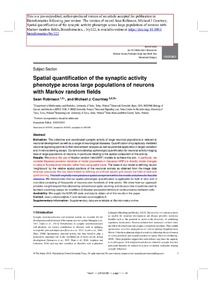Spatial quantification of the synaptic activity phenotype across large populations of neurons with Markov random fields
Sean Robinson; Michael J. Courtney
Spatial quantification of the synaptic activity phenotype across large populations of neurons with Markov random fields
Sean Robinson
Michael J. Courtney
Julkaisun pysyvä osoite on:
https://urn.fi/URN:NBN:fi-fe2021042719489
https://urn.fi/URN:NBN:fi-fe2021042719489
Tiivistelmä
The collective and coordinated synaptic activity of large neuronal populations is relevant to neuronal development as well as a range of neurological diseases. Quantification of synaptically-mediated neuronal signalling permits further downstream analysis as well as potential application in target validation and in vitro screening assays. Our aim is to develop a phenotypic quantification for neuronal activity imaging data of large populations of neurons, in particular relating to the spatial component of the activity.
We extend the use of Markov random field (MRF) models to achieve this aim. In particular, we consider Bayesian posterior densities of model parameters in Gaussian MRFs to directly model changes in calcium fluorescence intensity rather than using spike trains. The basis of our model is defining neuron 'neighbours' by the relative spatial positions of the neuronal somata as obtained from the image data whereas previously this has been limited to defining an artificial square grid across the field of view and spike binning. We demonstrate that our spatial phenotypic quantification is applicable for both in vitro and in vivo data consisting of thousands of neurons over hundreds of time points. We show how our approach provides insight beyond that attained by conventional spike counting and discuss how it could be used to facilitate screening assays for modifiers of disease-associated defects of communication between cells.
We supply the MATLAB code and data to obtain all of the results in the paper.
sean.j.robinson@utu.fi and michael.courtney@utu.fi.
Supplementary data are available at Bioinformatics online.
Motivation
Results
Availability
Contact
Supplementary Information
We extend the use of Markov random field (MRF) models to achieve this aim. In particular, we consider Bayesian posterior densities of model parameters in Gaussian MRFs to directly model changes in calcium fluorescence intensity rather than using spike trains. The basis of our model is defining neuron 'neighbours' by the relative spatial positions of the neuronal somata as obtained from the image data whereas previously this has been limited to defining an artificial square grid across the field of view and spike binning. We demonstrate that our spatial phenotypic quantification is applicable for both in vitro and in vivo data consisting of thousands of neurons over hundreds of time points. We show how our approach provides insight beyond that attained by conventional spike counting and discuss how it could be used to facilitate screening assays for modifiers of disease-associated defects of communication between cells.
We supply the MATLAB code and data to obtain all of the results in the paper.
sean.j.robinson@utu.fi and michael.courtney@utu.fi.
Supplementary data are available at Bioinformatics online.
Motivation
Results
Availability
Contact
Supplementary Information
Kokoelmat
- Rinnakkaistallenteet [19207]
